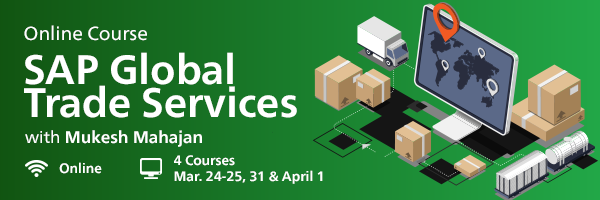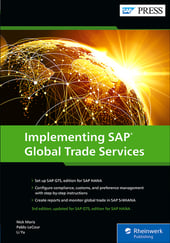The feeder system and SAP Global Trade Services (SAP GTS) are linked via a plug-in to enable communication between both systems.
The plug-in allows the transfer of master data and transactional documents between the feeder system and SAP GTS. You can transfer a transactional document from the feeder system only if the user has created all required master data—that is, the materials and business partners (customers, vendors, etc.) used in the transactional document—in SAP GTS. If the master data isn’t available in SAP GTS, then the document gets a technical incomplete status in the Compliance Management functionality or doesn’t generate a complete customs declaration in the Customs Management functionality.
Note: The SAP GTS, edition for SAP HANA (release 2023) plug-in is an integrated component of SAP S/4HANA.
Before you can transfer transactional documents from the feeder system to SAP GTS, you have to activate business add-ins (BAdIs). A BAdI is an enhancement to the standard version of SAP. You can define BAdIs by application levels, which in turn identify transaction categories (namely inbound or outbound, purchase order or sales order, etc.). We can divide the existing BAdIs into the following application levels:
- MM0A: Receipt/Import: Purchasing Document (e.g., purchase orders)
- MM0B: Receipt/Import: Inbound Delivery Document (e.g., inbound deliveries)
- MM0C: Receipt/Import: Material Document (e.g., goods receipt material documents)
- SD0A: Dispatch/Export: Sales Document (e.g., sales orders)
- SD0B: Dispatch/Export: Outbound Delivery Document (e.g., outbound deliveries)
- SD0C: Dispatch/Export: Billing Document (e.g., pro forma invoices)
The figure below shows the application levels, which are also used during the configuration of the document structure in SAP GTS. These settings can be retrieved by navigating the following path in the Customizing settings of SAP S/4HANA accessed via Transaction SPRO: SAP Reference IMG > Integration with Other SAP Components > Integration with Governance, Risk and Compliance > SAP Global Trade Services > Control Data for Transfer to SAP Global Trade Services > Configure Control Settings for Document Transfer.

After you’ve activated the relevant BAdIs, you can specify transactional documents for each application level via Transaction SPRO: Integration with Other SAP Components Integration with Governance, Risk and Compliance > SAP Global Trade Services > Control Data for Transfer to SAP Global Trade Services > Configure Control Settings for Document Transfer. In this transaction, you choose which document types need to be transferred for every application level; for example, you might transfer the purchase orders with document type NB. In this scenario, an entry is added for application level MM0A with document type FNB. For document type FNB, F represents the document category (purchasing), and NB represents the purchase order document type.
As shown in the following figure, you can specify the services (e.g., Compliance, Customs, Risk, etc.) for which the document must be transferred and whether an output dialog should be shown in the feeder system (e.g., stating that the document is blocked for compliance).

In the SAP S/4HANA feeder system, as of version 2021, you can restrict document transfer using the company code in addition to the document type. You specify the relevant company codes in the Document Type/Company Codes subfolder, as shown here.

In some cases, you may need to execute additional configuration. The available configuration settings depend on the relevant application level.
Learn SAP GTS in Our Upcoming Rheinwerk Course!
Navigate volatile global supply chains with SAP GTS, edition for SAP HANA! Learn its architecture and configuration and dive into customs, compliance, and preference management to cover your global operations. Click on the banner below to learn more and order your ticket.
Editor’s note: This post has been adapted from a section of the book Implementing SAP Global Trade Services by Nick Moris, Pablo LeCour, and Li Yu.




Comments